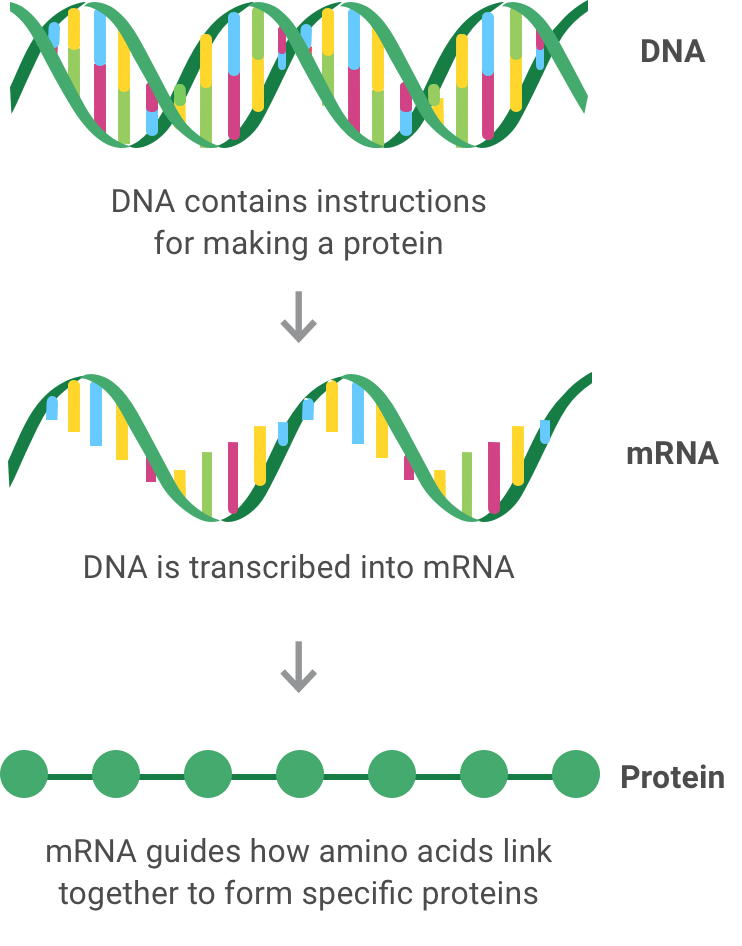Learn more
This is not a comprehensive list of resources, and it is provided for reference only.

Genes serve as an instruction booklet for cells so they can do all that is needed for a person to develop, survive, and reproduce. For the instructions to be used by cells, a gene's DNA sequences must be converted into messages. The messages tell the body how to produce proteins, the complex molecules that do most of the work in our bodies.
For the genetic code to be read by the cells, it must undergo a 2-step conversion process

DNA is transcribed into a molecule called messenger ribonucleic acid (mRNA).
mRNA links amino acids together in a precise order to produce a specific protein. This is important because there are about 20 amino acids, which can be arranged to form many different proteins. Proteins have different functions in different parts of the body. Some proteins have a role in building specific tissues, while other proteins are involved in the body's functions that sustain life.
A gene's instructions are written in a sequence made up of 4 nucleic acids, which serve as the building blocks of DNA: adenine (A), cytosine (C), guanine (G), and thymine (T). These nucleic acids form groups of 3, called codons, each of which corresponds to a specific amino acid and determines the composition of a protein. Scientists use the first letter of each nucleic acid to depict genetic code.
Potential variants leading to a gene's message not working properly
Genetic diseases are caused—in whole or in part—by 1 or more gene variants. Many genetic diseases are present at birth, but others may not show symptoms until later in life. However, symptoms of single-gene diseases often occur in childhood and can cause severe illness, or even death. Diseases that involve multiple genes may be more likely to appear in adulthood or later in life.
| Type | A single gene variant | Multiple gene variants | Variations to the structures that carry genes |
|---|---|---|---|
| Type of disease | Monogenic diseases | Polygenic diseases, complex or multifactorial disorders | Chromosomal diseases |
| Inheritance |
|
|
|
| Examples of diseases in this category* | Sickle cell disease, cystic fibrosis, myotonic dystrophy, Pompe disease, Duchenne muscular dystrophy, spinal muscular atrophy, X-linked myotubular myopathy (XLMTM) | Some forms of cancer, type 2 diabetes mellitus, heart disease | Down syndrome, Turner syndrome |
| Type | A single gene variant |
|---|---|
| Type of disease | Monogenic disease |
| Inheritance |
|
| Examples of diseases in this category* | Sickle cell disease, cystic fibrosis, myotonic dystrophy, Pompe disease, Duchenne muscular dystrophy, spinal muscular atrophy, X-linked myotubular myopathy (XLMTM) |
| Type | Multiple gene variants |
|---|---|
| Type of disease | Polygenic diseases, complex or multifactorial disorders |
| Inheritance |
|
| Examples of diseases in this category* | Some forms of cancer, type 2 diabetes mellitus, heart disease |
| Type | Variations to the structures that carry genes |
|---|---|
| Critical name | Chromosomal diseases |
| Inheritance |
|
| Examples of diseases in this category* | Down syndrome, Turner syndrome |
This is not a comprehensive list of resources, and it is provided for reference only.